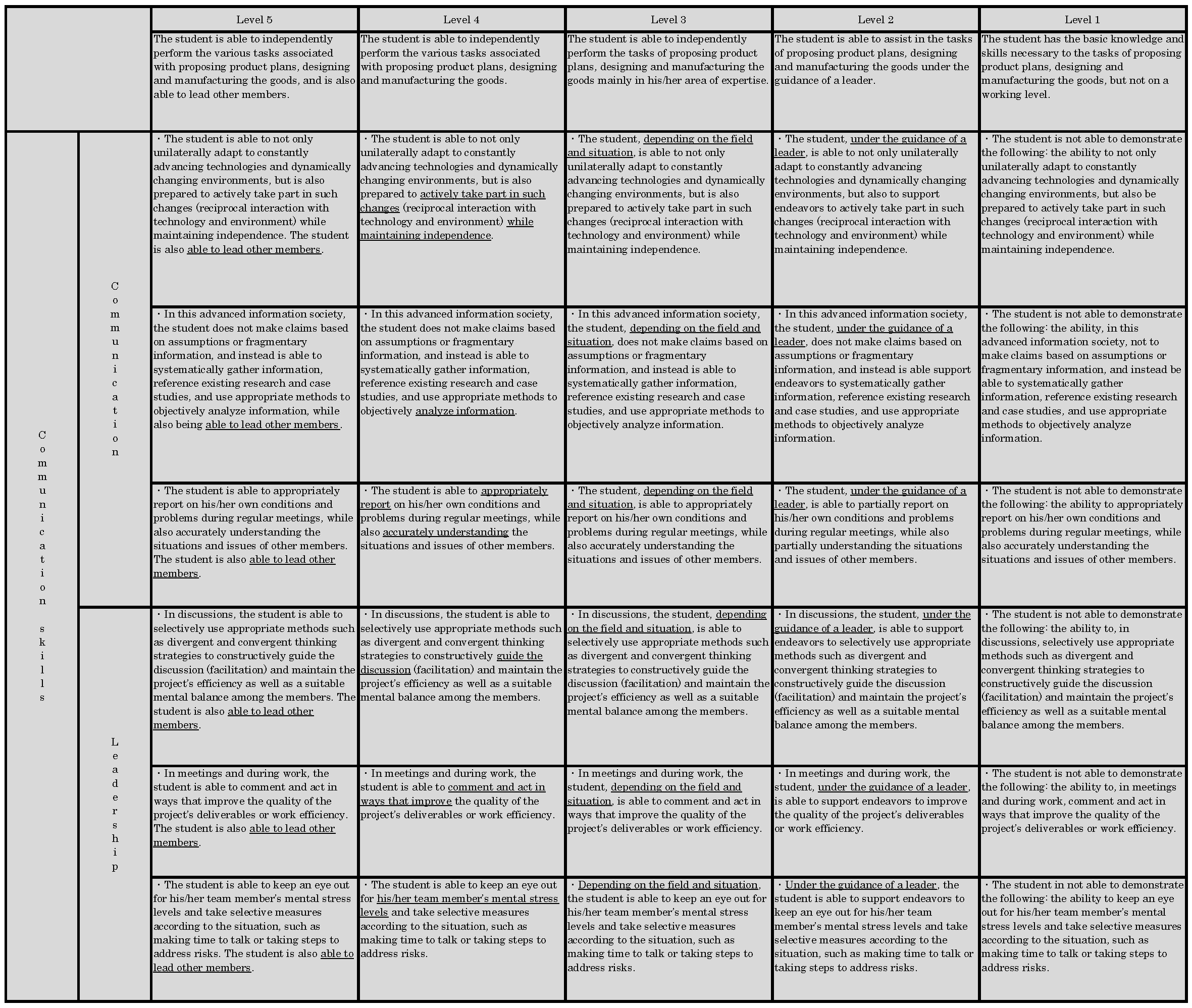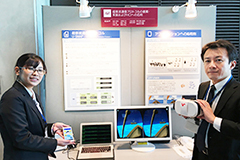Project-based Learning

AIIT PBL Method
As a professional graduate school, the Advanced Institute of Industrial Technology (AIIT) develops professionals who are needed by corporations. Most of the work is run on a project-to-project basis where employees of corporations are required to acquire the skills to work on projects. In addition, the problems faced at work are very complicated, and there is no correct answer. To equip students with the necessary skills and competencies (practical ability to accomplish tasks) and to solve such problems from a broad, cross-sectional perspective, AIIT employs Project Based Learning (PBL).
PBL is an effective educational technique designed to foster professionals who can be expected immediate contribution in the real world. Small groups of students define clear project goals and cooperate to complete each project as similar as possible to what they would encounter in the actual world of work. In the process, students acquire practical skills and expertise that are truly beneficial for employment. Most graduate schools focus on research and require students to write theses in order to earn a master's degree. With PBL, on the other hand, the major difference is that students work as a team on a project, the project in the process is evaluated, and students then present the specific result of the project. AIIT helps students acquire basic knowledge and skills in the first year and offers PBL activities during the second year so that students acquire the needed competencies through practical studies, which are a requirement for completing the course. At AIIT, the methodology of the PBL programs is called the AIIT PBL Method.
Features of the PBL program at AIIT
Quality and quantity at the graduate school level
- Compulsory subjects for a master's degree instead of a thesis
→The scale and content of projects at a practical level.
Gaining experience and acquiring competencies
- First year: Acquisition of knowledge and skills
- Second year: Acquisition of competencies (students spend most of their time acquiring competencies.)
Members of PBL
- As with regular operations, PBL groups consist of several members.
- Diversity of members (age, occupation, professional position, experience, etc.)
Unique AIIT PBL methods
- Project planning, schedule management, quality evaluation and assurance, achievement assessment, scrum, learn, etc.
- Within the PBL rules and framework, the instructors in charge of PBL programs set up the content for each project.
AIIT PBL is a groundbreaking approach even on a global scale.
PBL constitutes the core of the AIIT degree program.
AIIT does not require students to write a thesis, which is required by most graduate schools. Instead, students spend their second year in PBL programs. This means that PBL requires the quality and quantity of a graduate school. AIIT is a professional graduate school that trains students to become advanced professional technicians who can succeed in the business community. While most graduate schools use theses to determine the acquisition of advanced professional knowledge, AIIT determines the acquisition of advanced competencies through PBL activities.
All of the AIIT PBL themes are practical so that students can take part in a relatively large project by selecting a theme. Students acquire the knowledge, skills, and expertise necessary to become advanced professional technicians by spending an entire year working on a project with practical content and scale.
Educational AIIT PBL program
The AIIT PBL is offered as compulsory subjects during the final academic year of the curriculum. The PBL program is equivalent to the theses in other graduate schools. Specifically, AIIT offers PBL education as a requirement for a master's degree in place of a thesis. The AIIT PBL is the most unique and important program and comprises 12 credits (six credits for the first semester and six credits for the second semester) out of the 40 credits required for completion.
AIIT employs a quarter system where students take basic and specialized subjects in four cycles to acquire basic knowledge and skills in the first year. In the second year, students spend an entire year working on a PBL project in two cycles of the first and second semester. An array of problems that students may face in the real world is not as simple as a problem that they can solve with the knowledge acquired through systematic education implemented in ordinary graduate schools. Such a problem has the complexity of being difficult even to understand its substance using traditional knowledge. AIIT employs PBL to foster professionals who can bring real-life problems to a close. This allows students to acquire practical competencies by capitalizing on acquired knowledge and skills.

The goal of AIIT PBL is to equip students with systematic knowledge and the skills necessary for the development of information systems and monozukuri, as well as the practical skills necessary for actual work. AIIT defines the abilities for carrying out work as competencies, which students must acquire through PBL. Competencies consist of three meta competencies and the core competencies set up by each course.
Meta competencies
- Communication skills
- Continuous learning and research skills
- Team activities
Core competencies for the Master Program of Information
Systems Architecture
- Ability to gererate innovative concept and ideas
- Social- and market-oriented viewpoints
- Ability to analyze needs
- Modeling and systems proposal
- Management skills
- Negotiation skills
- Documentation skills
Core competencies for the Master Program of Innovation
for Design and Engineering
-
Idea-generation ability
Ability to plan and implement ideas, Originality -
Ability to express ideas
Ability to define requirements and make proposals, Visualization skills -
Design skills
Functional design skills, Inspirational design skills, Ability to integrate
function and Inspiration -
Development skills
Development preparation skills, Implementation skills, Tests, prob-
lem-solving skills -
Analytical skills
Data analysis skills, usability assessment skills, market research skills
Projects and educational goals
In each project, students participate in activities related to challenges and find solutions. As a result, they produce the project deliverables. In PBL, students learn by working in a series of project processes. Through PBL, students acquire the technique (activities) to overcome challenges so that they acquire new skills, acquire new knowledge, and become to be able to apply the knowledge to other problems, which is the educational goal of PBL.
What students can learn through PBL
| Students learn how to use and apply knowledge to overcome project challenges (to implement an activity) | Students think independently (realization) instead of having others provide the answers. |
| Students learn techniques (to apply to similar problems) | (The characteristics of planning and design operation): Various limitations, concepts of values, and judgment of trade-offs. |
| Students take the initiative and acquire the new knowledge necessary to fulfill their roles. | Continuous development of academic ability and skills. |
| Students employ different perspectives, concepts of values,and viewpoints to improve instead of thinking alone. | Understanding of diversity |
| Students learn to execute and manage projects (by working with several team members.) | Activities as a team (team members) Project management |
| Students acquire the necessary skills to provide services. | Proper understanding of expectations. |
Management System
To set the themes for PBL, external experts from member corporations of the Management Advisory Council established at AIIT are invited to incorporate opinions from the business community by setting up a PBL panel consisting of external and internal experts made up of AIIT faculty members. The council discusses current issues raised by external experts, and the AIIT faculty members propose draft themes to the council. The opinions of the external experts on the themes are incorporated to determine the themes of PBL for the next academic year.
When PBL themes are set by the instructors in charge of PBL without input from other experts, the themes tend to have a disproportionate emphasis on the research areas of the current instructors. AIIT eliminates such problems so that the themes do not have an in-depth but narrow outlook. In addition, AIIT PBL adopts an external evaluation panel system by inviting experts related to PBL themes to periodically review all PBL activities.
PBL Activities
AIIT's PBL program requires students to earn 12 credits during the first semester and the second semester. Because of this requirement, in principle, students must spend nine hours a week (six slots of class hours) in team activities and nine hours of after-class work for 30 consecutive weeks. For after-class work, students work on preliminary studies of the necessary knowledge for team activities and the research of assignments allotted to members among the activities. Students generally spend 18 hours in the activity. AIIT PBL requires students to submit deliverables suitable for these hours.
Students implement PBL by creating a project plan document. Students plan how to use the 18 hours, which is the indicator for the weekly activity, and the type of a project to proceed. During the duration of PBL, students engage in project activities based on the plan and report and submit project activities using the AIIT PBL support system. All faculty members share the information on the activities of individual students.
PBL Activity Report
- Record all details of project activities and add to the Backlog.
- Record individual activities in a weekly report with submission on the Learning Management System (LMS).
- At the end of each quarter, submit a self-assessment on the LMS.
- At the end of the first semester and the second semester, submit a project activity report.
- At the end of the second semester, submit an annual activity report. (Published externally)
PBL's annual schedule
AIIT PBL is equivalent to writing a thesis in other graduate schools. Students spend the whole second year completing one project. They start preparing for the activities of PBL from January of the first year, where students are assigned to a team, and start activities from April. Halfway through, students in the Master Program of Innovation for Design and Engineering hold three intermediate project presentations and students in the Master Program of Information Systems Architecture hold one intermediate project presentation. In February, the final project presentation meeting is held at an off-campus venue, being open to the public.
Team composition and guidance system
Similar to regular work, AIIT PBL employs teams consisting of several members. However, the members are highly diverse and consist of students of different ages, occupations, professional positions, and experience. While it is difficult to carry out PBL in this way, students can expect to gain new knowledge that cannot be obtained through regular work on a team, which consists of members with similar knowledge and experience.
Each team is made up of five students. Students engage in the team activities of AIIT PBL by assuming active roles as a member of the team. Team members have a common goal and fulfill their roles on the team to achieve results. Students learn in the process of overcoming challenges. In addition, as stated earlier, students learn from other team members thanks to the diversity of the team.
One primary instructor and two sub-instructors are assigned to each team and provide guidance. Instructors teach the team how to proceed with a project while grasping student activities and results. Based on the results, instructors provide guidance and evaluate each student. For team learning, while it is difficult to evaluate each team member at an individual level, the structure and evaluation system ensure that three instructors objectively evaluate the results as much as possible.
Weekly report and self-assessment
Students report activities and results of a week as a weekly report. The weekly report is used to describe all after-class work and team activities. The weekly report is mainly used to share the details of activities at an individual level and the number of activities. In addition, based on the activities and achieved results recorded in the weekly report, a self-assessment is submitted four times a year to reflect on student studies. At the end of each quarter, students reflect on their project activities and describe the skills and competencies they have acquired. The self-assessment is mainly used for qualitative assessment (assessment of the quality of activities.)
| Weekly report Items | Detalls of weekly report and notes |
|---|---|
| This week's activities and achieved results | Describe one's activities for the week and the status of the deliverables from the result. Be sure to create deliverables so that others and the instructors can see. |
| Next week's activities and the plans for achievement | Describe the goals for next week's activities and the plans for the expected deliverables. |
| Challenges and solutions | Describe the challenges of the week, as well as the challenges overcome for the week and the solutions. |
| Events and awareness | Describe memorable events and one's awareness of the entire project. |
| Special notes | Describe other special notes and requests for other members and instructors. |
AIIT PBL Support System
Backlog
The website for PBL projects and file management

LMS(manaba)
The website for the submission of activity reports and information sharing for instructors

PBL result evaluation system
What elements are evaluated?
For AIIT PBL, each student is evaluated, not the success or failure of the project. Student's contribution to PBL activities and the degree of competencies acquired are part of the evaluation of each student. To evaluate the student's contribution, the participation level in regular PBL activities, the quantity and quality of deliverables created are evaluated. To evaluate student competencies, the competencies acquired through PBL activities that meet the level of a master's degree for specialists are evaluated. The key point is what the students learned and how much the students grew through PBL during the year.
Who does the evaluation?
For the evaluation, PBL result judgement meetings are convened four times a year, which are attended by all dedicated instructors. Three instructors (one primary instructor and two sub-instructors) are assigned to all students enrolled in PBL to prepare drafts of the result evaluation. All dedicated instructors discuss the drafts at the PBL result judgement meeting. The PBL evaluation makes these efforts to ensure objectivity and the adequacy of the evaluation. The opinions from an external evaluation panel after monthly reviews and the Final Project Presentation Meeting are used as a reference.
Evaluation method
- The evaluation of PBL activities and quality and quantity of deliverables
Based on the deliverables and reports from students (weekly report, self-assessment, etc.), the evaluation is carried out according to the following PBL evaluation matrix. With this, the hours spent on PBL activities and the quality of deliverables appropriate for the time spent are evaluated.
PBL evaluation matrix Quallty evaluation Quantity evaluation PBL activities Project management
Roles, contribution, etc.Activity hours
Late attendance, absence, etcPBL dellverables The quality of documents,
software, hardware, theses, etc.The quantity of deliverables
that meets the standards. - The evaluation of acquisition level of competencies
For the meta competencies and the core competencies set by each course, the skill level of the competencies is clearly defined on a scale of one to five. The achievement level of competencies acquired by students is evaluated using the evaluation standards for the skill level.
Meta competencies skill level (partially excerpt)

The 2017 AIIT PBL Project Presentation Meeting was held

The Advanced Institute of Industrial Technology held the 2017 AIIT PBL Project Presentation Meeting for the tenth time since its establishment at the Tokyo International Forum on Saturday, February 11, 2017 (national holiday.)
Project-Based Learning (PBL) of AIIT is a practical experience-oriented educational method. Students define clear project goals and through the PBL process they acquire the practical skills and expertise that are truly beneficial in the information technology (IT) and monozukuri industries.

This PBL is equivalent to theses in graduate schools that focus on research. Students in the second year spend an entire year working on one PBL project.
Now in its tenth year, the 2017 AIIT PBL Project Presentation Meeting was again viewed by many guests and ended on a high note.
AIIT PBL Interview
For the purpose of a better understanding of PBL, which is the greatest characteristic of AIIT courses, AIIT professors were interviewed by a professional reporter on the subject of PBL, titled AIIT PBL Interview.
In the interviews, the professors who directly teach students discussed AIIT’s basic idea of PBL, specific activities in PBL projects, and how students put effort into their projects. The interviews provided first-hand information on what is happening in the classrooms.
This section is updated in series. We hope that the interviews help people who are considering AIIT and those in the business community and educational circles know what AIIT and PBL have to offer.
[Interviewer]
Mariko Yoneda
A freelance reporter who has written for the Weekly Diamond, President, and Weekly Shincho. Specializing in finances, economics and management, she reports on new business models, interviews with top executives, universities, and graduate schools, regardless of business category. A graduate of the Faculty of Law, Kyoto University.

Twelfth Interview
- Large-scale project simulation and the development of e-Learning materials on PBL (click here (Japanese version))
Master Program of Information Systems Architecture
Professor Yoichi Seto

Eleventh Interview
- Fore-running in information security -PBL on the theme of developing challenges- (click here (Japanese version))
Master Program of Information Systems Architecture
Professor Yoichi Seto

Tenth Interview
- Development of monozukuri models by community-based questions and answers - PBL, which shares the process and efforts with the local community- (click here (Japanese version))
Master Program of Innovation for Design and Engineering
Professor Yoshie Kunisawa

Ninth Interview
- What type of design does AIIT teach? –What to learn before starting PBL?- (click here (Japanese version)
Master Program of Innovation for Design and Engineering
Professor Yoshie Kunisawa

Eighth Interview
- Proposing urban-type dynamic design for 2030 -Brushing up competencies through PBL- (click here (Japanese version))
Master Program of Innovation for Design and Engineering
Professor Tetsuo Fukuda

Seventh Interview
- What is needed is the integrated knowledge and design ethics -Industrial design that changes society- (click here (Japanese version))
Master Program of Innovation for Design and Engineering
Professor Tetsuo Fukuda

Sixth Interview
- Simulation of large-scale projects and PM’s blended education –The reality of project management PBL- (click here (Japanese version))
Master Program of Information Systems Architecture
Professor Kiyoshi Sakamori

Fifth Interview
- Hot skills for building your career –Learning project management- (click here (Japanese version))
Master Program of Information Systems Architecture
Professor Kiyoshi Sakamori

Fourth Interview
- Bringing solutions to management challenges of corporations –IT solution for realizing the desire of top management-- (click here (Japanese version))
Master Program of Information Systems Architecture
Professor Yoshio Tozawa

Third Interview
- Acquiring IT to meet the industrial needs -Studies aimed at information system architect- (click here (Japanese version))
Master Program of Information Systems Architecture
Professor Yoshio Tozawa

Second Interview
- Building new services for protecting everyday household -All facts about the projects participated by students on a high level- (click here (Japanese version))
Dean of the School of Industrial Technology, Advanced Institute of Industrial Technology
Professor Seiichi Kawata

First Interview
- Practice of projects on the subject of advanced technology -Acquiring advanced business skills- (click here (Japanese version))
Dean of the School of Industrial Technology, Advanced Institute of Industrial Technology
Professor Seiichi Kawata
